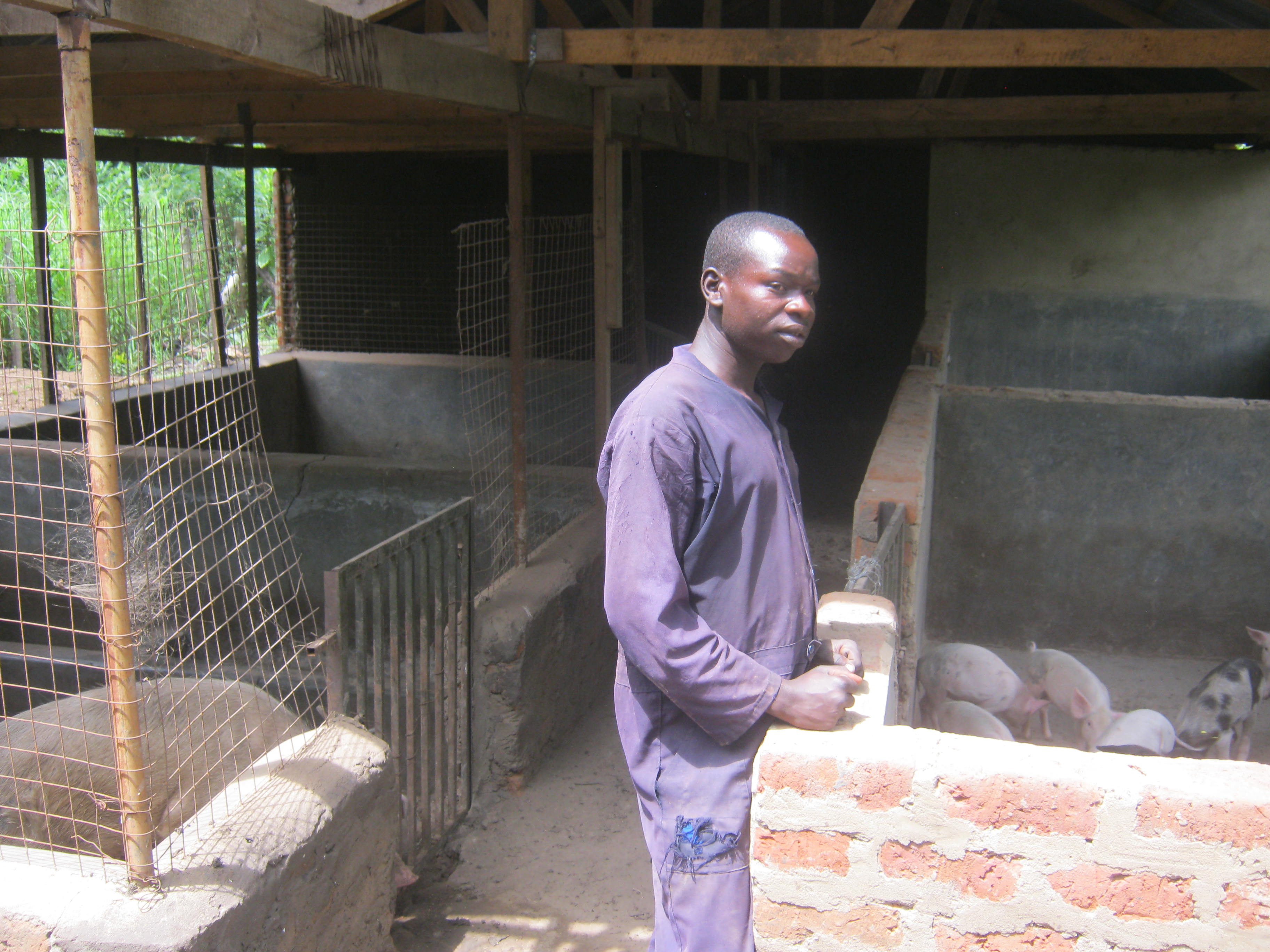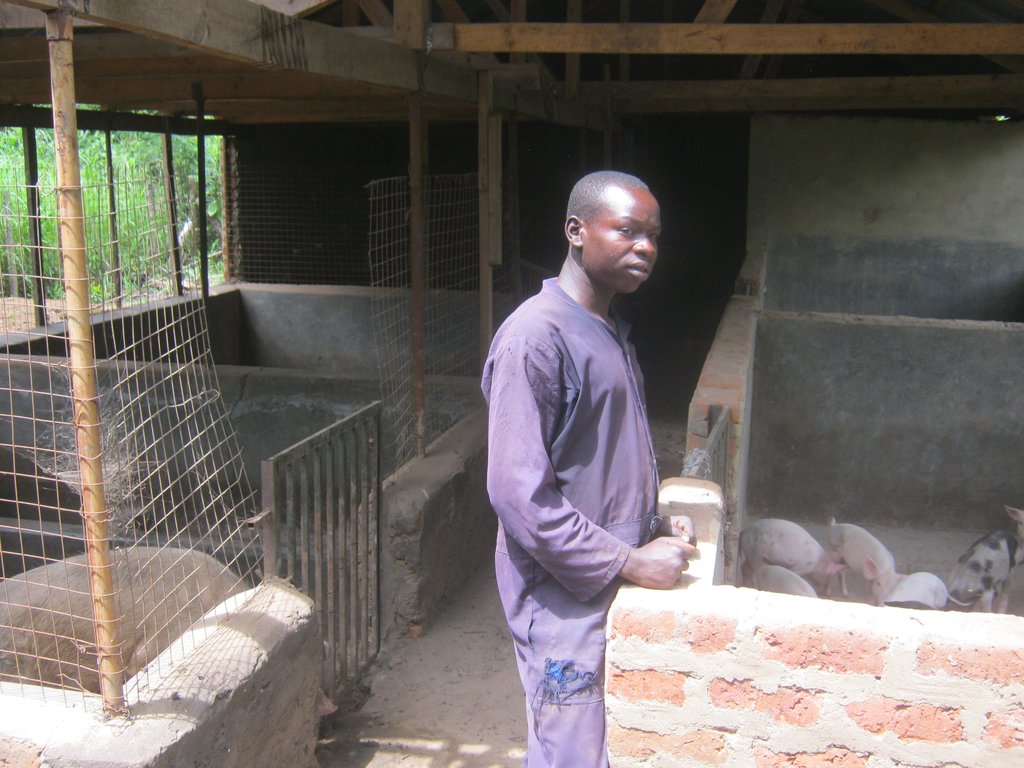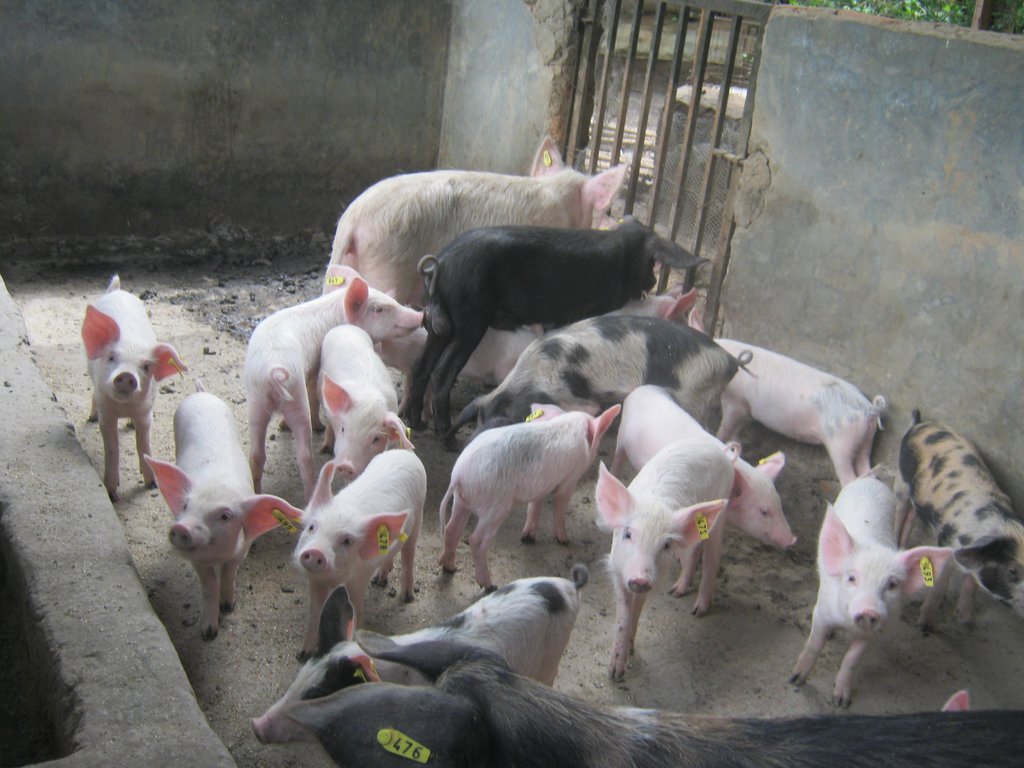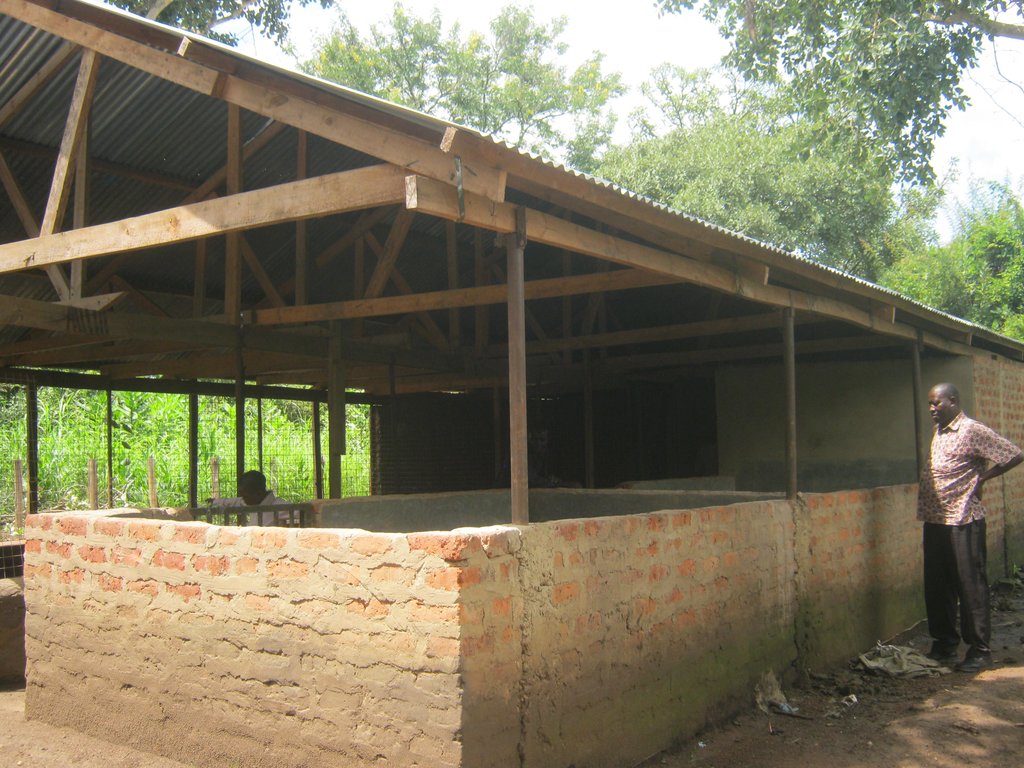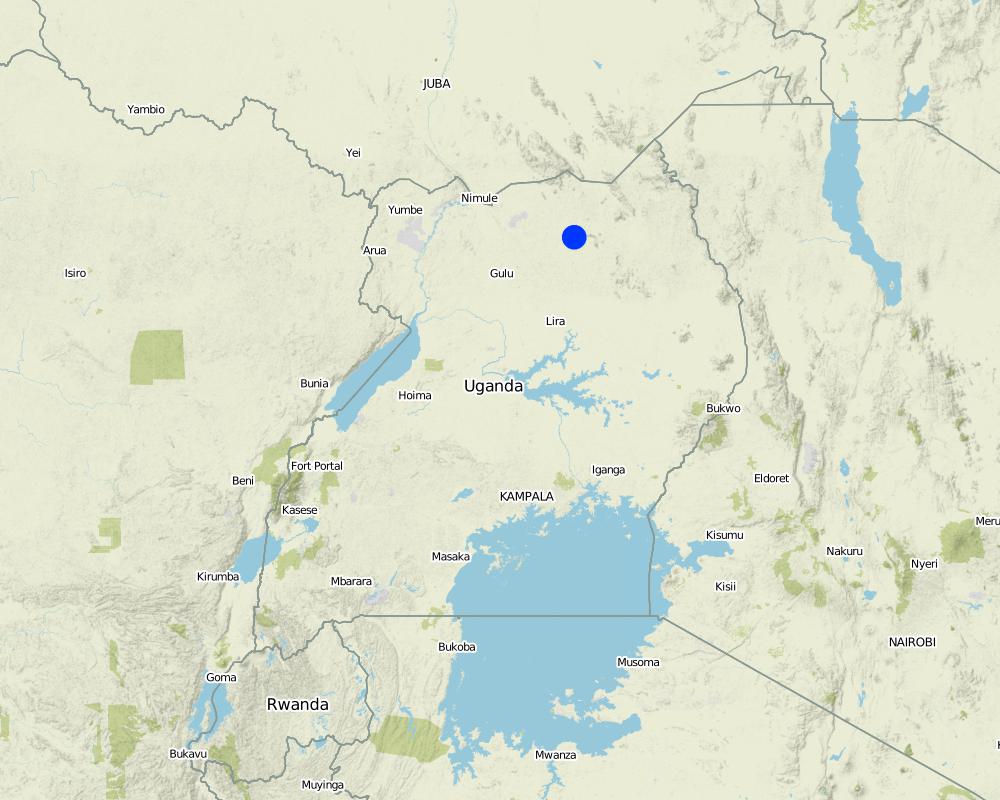Intensive Pig farming for soil fertility improvement and household income [乌干达]
- 创建:
- 更新:
- 编制者: Kamugisha Rick Nelson
- 编辑者: JOY TUKAHIRWA, Sunday Balla Amale, Richard Otto Kawawa, Bernard Fungo
- 审查者: Drake Mubiru, Nicole Harari, Renate Fleiner, Donia Mühlematter
Gwoko Opego Kidyang Pi Yubu Moc can
technologies_2812 - 乌干达
查看章节
全部展开 全部收起1. 一般信息
1.2 参与该技术评估和文件编制的资源人员和机构的联系方式
关键资源人
土地使用者:
Pito Alex
Farmer
Kitgum District
乌干达
有助于对技术进行记录/评估的项目名称(如相关)
Scaling-up SLM practices by smallholder farmers (IFAD)有助于对技术进行记录/评估的机构名称(如相关)
CDE Centre for Development and Environment (CDE Centre for Development and Environment) - 瑞士1.3 关于使用通过WOCAT记录的数据的条件
(现场)数据是什么时候汇编的?:
10/05/2017
编制者和关键资源人员接受有关使用通过WOCAT记录数据的条件。:
是
1.4 所述技术的可持续性声明
这里所描述的技术在土地退化方面是否存在问题,导致无法被认为是一种可持续的土地管理技术?:
否
2. SLM技术的说明
2.1 技术简介
技术定义:
Pigs are kept to produce manure used for soil fertility improvement and household income.
2.2 技术的详细说明
说明:
Pig farming has become a popular and lucrative business among farmers in Northern Uganda. It is considered to be a quick means of improving soil fertility and household incomes, thus improving land productivity and reducing poverty.
Pigs are normally fed reguraly on maize bran purchased or maize grain produced as the most common food ration but could also benefit from having a ratio with protein from soybeans produced on farm, and home-made feeds mainly in the form of cassava, brew waste and potatoes as well as adequate supply of drinking water for purposes of fattening, animal manure and income provision.
10-12 pigs are kept in a pen measuring 6 to 8 m wide, 8 m long and 3.5 m high with a space for feeding and bedding. The materials needed for constructing the pen are iron sheets, wood, and nails. Sanitation in pig farming is important in order to keep the pigs disease-free. Therefore, a mechanism for easy cleaning and removal of waste is necessary for any type of pig housing using sawdust. The farmer uses simple local brooms, basins, and buckets to clean and remove manure on a daily basis and applied in nearby gardens
After five to seven months, pigs are likely to have attained an ideal market weight of more than 70 – 100kg. The farmer may decide to sell or slaughter for meat. Compared to most livestock species, pigs have a higher turnover rate due to a shorter gestation period in addition to providing manure which the farmer applies on the gardens to increase soil fertility for increased food production. Pigs also have higher returns on investment due to a larger litter size and higher feed conversion ratio. These factors make pig farming a more profitable livestock enterprise, since more meat is produced and sold in a shorter period, relative to other domestic animals.
However, the farmer needs to be aware that pigs are easily attacked by bacteria and virus related diseases, which result into diarrhoea, leading to death. Treatment requires high-level skills, which may need the attention of an extension worker to provide advisory services and treatment in case they fall sick.
2.3 技术照片
2.4 技术视频
注释、简短说明:
Video showing intensive goat and pig farming tethered for manure.
日期:
10/05/2017
位置:
Akobi Parish, Kitgum District
摄影师的名字:
Issa Aiga
2.5 已应用该技术的、本评估所涵盖的国家/地区/地点
国家:
乌干达
区域/州/省:
Northern Region,Uganda
注释:
Map showing technology site in Northern Uganda.
Map
×2.6 实施日期
注明实施年份:
2015
如果不知道确切的年份,请说明大概的日期:
- 不到10年前(最近)
2.7 技术介绍
详细说明该技术是如何引入的:
- 通过土地使用者的创新
- 通过项目/外部干预
注释(项目类型等):
Started as a Model farmer under National Agricultural Advisory services (NAADS).
3. SLM技术的分类
3.1 该技术的主要目的
- 改良生产
- 减少、预防、恢复土地退化
- 适应气候变化/极端天气及其影响
- 创造有益的经济影响
- Improve learning with the community on tithered livestock mangement for manure
3.2 应用该技术的当前土地利用类型

混合(作物/放牧/树木),包括农林
- 农林牧业
主要产品/服务:
Cropland (maize).
Pigs=12 , poultry=8, cattle=4.
Planted trees (avocado and calliandra) as feed supplement.
如果由于技术的实施而导致土地用途发生变化,则在技术实施前说明土地利的用途。:
Cropland growing Maize.
3.3 有关土地利用的更多信息
该技术所应用土地的供水:
- 雨养
注释:
Have two rainy season. November to December and March to May.
每年的生长季节数:
- 2
具体说明:
July to December
牲畜密度(如相关):
Pigs=12 , poultry=8, cattle=4. to provide manure to supplement the Pig manure on farm.
3.4 该技术所属的SLM组
- 农畜综合管理
- 土壤肥力综合管理
- Piggery
3.5 技术传播
具体说明该技术的分布:
- 适用于特定场所/集中在较小区域
注释:
Controlled in one area.
3.6 包含该技术的可持续土地管理措施

农艺措施
- A2:有机质/土壤肥力

结构措施
- S9:动植物庇护所

管理措施
- M6:废物管理(回收、再利用或减少)
注释:
Pigs provide manure which is applied on maize field to increase production. Maize corn is fed to Pigs.
3.7 该技术强调的主要土地退化类型

化学性土壤退化
- Cn:肥力下降和有机质含量下降(非侵蚀所致)

生物性退化
- Bc:植被覆盖的减少
3.8 防止、减少或恢复土地退化
具体数量名该技术与土地退化有关的目标:
- 防止土地退化
- 修复/恢复严重退化的土地
注释:
Through use and application of manure from the tethered animals.
4. 技术规范、实施活动、投入和成本
4.1 该技术的技术图纸
4.2 技术规范/技术图纸说明
At least 10-12 pigs are kept in a pen measuring 6-8 wide, 8 meters long and 3.5 meters high with a space for feeding and bedding built using iron sheets, wood, nails and labour.
4.3 有关投入和成本计算的一般信息
具体说明成本和投入是如何计算的:
- 每个技术区域
注明尺寸和面积单位:
less than 0.05 acre, 6 to 8 m wide, 8 m long and 3.5 m high
其它/国家货币(具体说明):
UGX
注明美元与当地货币的汇率(如相关):1美元=:
3400.0
注明雇用劳工的每日平均工资成本:
7000
4.4 技术建立活动
| 活动 | 措施类型 | 时间 | |
|---|---|---|---|
| 1. | Select site where to put pigs | 管理 | Once before establishment |
| 2. | Build a pen for pigs | 管理 | Once before establishment |
| 3. | Look for inputs | 其它措施 | Once during estabslsihment/ routine |
| 4. | Purchase pigs | 农业学的 | Once during establsihment |
| 5. | Put pigs in the pen | 管理 | Once during establlsihment |
| 6. | Feedding pigs | 管理 | Daily |
| 7. | Watering pigs | 管理 | Daily |
| 8. | Spraying pigs | 管理 | Weekly |
4.5 技术建立所需要的费用和投入
| 对投入进行具体说明 | 单位 | 数量 | 单位成本 | 每项投入的总成本 | 土地使用者承担的成本% | |
|---|---|---|---|---|---|---|
| 劳动力 | Persons days on monthly basis | persons | 4.0 | 210000.0 | 840000.0 | 100.0 |
| 设备 | Nails | kgs | 10.0 | 2500.0 | 25000.0 | 100.0 |
| 设备 | Hoes | Pieces | 1.0 | 10000.0 | 10000.0 | 100.0 |
| 设备 | Spade | Pieces | 1.0 | 10000.0 | 10000.0 | 100.0 |
| 设备 | Wheel barrow | Pieces | 1.0 | 75000.0 | 75000.0 | 100.0 |
| 设备 | Iron sheets | pieces | 6.0 | 20000.0 | 120000.0 | 100.0 |
| 肥料和杀菌剂 | Pestcide | litres | 5.0 | 15000.0 | 75000.0 | |
| 施工材料 | Poles | Pieces | 20.0 | 5000.0 | 100000.0 | 100.0 |
| 施工材料 | wood | pieces | 15.0 | 5000.0 | 75000.0 | 100.0 |
| 其它 | Feeds on weekly basis | kgs | 100.0 | 3000.0 | 300000.0 | 100.0 |
| 技术建立所需总成本 | 1630000.0 | |||||
注释:
Labour costs are high during estabslishment and it is reduced over time.
4.6 维护/经常性活动
| 活动 | 措施类型 | 时间/频率 | |
|---|---|---|---|
| 1. | Cleaning and removing manure | 管理 | Daily |
| 2. | Giving drinking water to pigs | 管理 | Daily |
| 3. | Spraying the pigs | 管理 | Weekly |
| 4. | Feeding the pigs | 管理 | Daily |
| 5. | Manure application in the field to improve soil fertility | 管理 | Weekly |
4.7 维护/经常性活动所需要的费用和投入(每年)
| 对投入进行具体说明 | 单位 | 数量 | 单位成本 | 每项投入的总成本 | 土地使用者承担的成本% | |
|---|---|---|---|---|---|---|
| 劳动力 | persons days on monthly basis | persons | 4.0 | 210000.0 | 840000.0 | 100.0 |
| 劳动力 | 100.0 | |||||
| 技术维护所需总成本 | 840000.0 | |||||
注释:
High costs of labour because its routine compared to costs of equipment which are purchased during establishment.
4.8 影响成本的最重要因素
描述影响成本的最决定性因素:
Labour takes most of the costs because its required regularly during establishment and maintenance.
5. 自然和人文环境
5.1 气候
年降雨量
- < 250毫米
- 251-500毫米
- 501-750毫米
- 751-1,000毫米
- 1,001-1,500毫米
- 1,501-2,000毫米
- 2,001-3,000毫米
- 3,001-4,000毫米
- > 4,000毫米
指定年平均降雨量(若已知),单位为mm:
1200.00
有关降雨的规范/注释:
Two rainy seasons.
农业气候带
- 潮湿的
5.2 地形
平均坡度:
- 水平(0-2%)
- 缓降(3-5%)
- 平缓(6-10%)
- 滚坡(11-15%)
- 崎岖(16-30%)
- 陡峭(31-60%)
- 非常陡峭(>60%)
地形:
- 高原/平原
- 山脊
- 山坡
- 山地斜坡
- 麓坡
- 谷底
垂直分布带:
- 0-100 m a.s.l.
- 101-500 m a.s.l.
- 501-1,000 m a.s.l.
- 1,001-1,500 m a.s.l.
- 1,501-2,000 m a.s.l.
- 2,001-2,500 m a.s.l.
- 2,501-3,000 m a.s.l.
- 3,001-4,000 m a.s.l.
- > 4,000 m a.s.l.
说明该技术是否专门应用于:
- 凹陷情况
5.3 土壤
平均土层深度:
- 非常浅(0-20厘米)
- 浅(21-50厘米)
- 中等深度(51-80厘米)
- 深(81-120厘米)
- 非常深(> 120厘米)
土壤质地(表土):
- 中粒(壤土、粉土)
土壤质地(地表以下> 20厘米):
- 中粒(壤土、粉土)
表土有机质:
- 中(1-3%)
5.4 水资源可用性和质量
地下水位表:
< 5米
地表水的可用性:
好
水质(未处理):
良好饮用水
水的盐度有问题吗?:
否
该区域正在发生洪水吗?:
否
5.5 生物多样性
物种多样性:
- 低
栖息地多样性:
- 中等
5.6 应用该技术的土地使用者的特征
定栖或游牧:
- 定栖的
生产系统的市场定位:
- 混合(生计/商业
非农收入:
- 低于全部收入的10%
相对财富水平:
- 平均水平
个人或集体:
- 个人/家庭
机械化水平:
- 手工作业
性别:
- 男人
土地使用者的年龄:
- 青年人
- 中年人
5.7 应用该技术的土地使用者拥有或租用的平均土地面积
- < 0.5 公顷
- 0.5-1 公顷
- 1-2 公顷
- 2-5公顷
- 5-15公顷
- 15-50公顷
- 50-100公顷
- 100-500公顷
- 500-1,000公顷
- 1,000-10,000公顷
- > 10,000公顷
这被认为是小规模、中规模还是大规模的(参照当地实际情况)?:
- 中等规模的
5.8 土地所有权、土地使用权和水使用权
土地所有权:
- 个人,未命名
土地使用权:
- 社区(有组织)
用水权:
- 自由进入(无组织)
5.9 进入服务和基础设施的通道
健康:
- 贫瘠
- 适度的
- 好
教育:
- 贫瘠
- 适度的
- 好
技术援助:
- 贫瘠
- 适度的
- 好
就业(例如非农):
- 贫瘠
- 适度的
- 好
市场:
- 贫瘠
- 适度的
- 好
能源:
- 贫瘠
- 适度的
- 好
道路和交通:
- 贫瘠
- 适度的
- 好
饮用水和卫生设施:
- 贫瘠
- 适度的
- 好
金融服务:
- 贫瘠
- 适度的
- 好
6. 影响和结论性说明
6.1 该技术的现场影响
社会经济效应
生产
作物生产
SLM之前的数量:
0
SLM之后的数量:
250kgs
注释/具体说明:
Manure application on the maize field to improve soil fertility.
作物质量
注释/具体说明:
Especially maize.
饲料生产
注释/具体说明:
For feeding the pigs.
畜牧生产
注释/具体说明:
Good feeding/purchase after sell of maize.
土地管理
注释/具体说明:
manure application.
水资源可用性和质量
饮用水的质量
家畜用水的质量
SLM之前的数量:
0
SLM之后的数量:
1 water harvesting tank
注释/具体说明:
to be used for drinking by the pigs.
收入和成本
农业投入费用
注释/具体说明:
Spend on pesticides.
农业收入
SLM之前的数量:
0
SLM之后的数量:
800000
注释/具体说明:
sale of maize and 2 pigs.
工作量
注释/具体说明:
Looking after pigs and maize on farm.
社会文化影响
食品安全/自给自足
注释/具体说明:
Especially with the harvest of maize.
SLM/土地退化知识
注释/具体说明:
Training on planting maize, feeding the pigs and manure application in the maize field.
生态影响
土壤
土壤覆盖层
注释/具体说明:
Animal manure application in the maize field.
土壤流失
注释/具体说明:
Zero grazing avoiding overgrazing.
土壤有机物/地下C
注释/具体说明:
Due to application of manure.
生物多样性:植被、动物
植被覆盖
注释/具体说明:
Zero grazing.
有益物种
注释/具体说明:
Pigs.
害虫/疾病控制
注释/具体说明:
Support from extension workers.
6.2 该技术的场外影响已经显现
对邻近农田的破坏
注释/具体说明:
Zero grazing as pigs are destructive.
6.3 技术对渐变气候以及与气候相关的极端情况/灾害的暴露和敏感性(土地使用者认为的极端情况/灾害)
渐变气候
渐变气候
| 季节 | 气候变化/极端天气的类型 | 该技术是如何应对的? | |
|---|---|---|---|
| 年温度 | 增加 | 适度 | |
| 季节性温度 | 湿季/雨季 | 增加 | 适度 |
6.4 成本效益分析
技术收益与技术建立成本相比如何(从土地使用者的角度看)?
短期回报:
轻度消极
长期回报:
积极
技术收益与技术维护成本/经常性成本相比如何(从土地使用者的角度看)?
短期回报:
轻度消极
长期回报:
稍微积极
注释:
Short term- High costs on labour and inputs.
Long term - Low costs required only for labour to maintain the technology.
6.5 技术采用
- 10-50%
如若可行,进行量化(住户数量和/或覆盖面积):
5
在所有采用这项技术的人当中,有多少人是自发地采用该技术,即未获得任何物质奖励/付款?:
- 50-90%
6.6 适应
最近是否对该技术进行了修改以适应不断变化的条件?:
是
若是,说明它适应了哪些变化的条件:
- 气候变化/极端气候
具体说明技术的适应性(设计、材料/品种等):
Planted Agroforestry trees ( avocado and calliandra) as feed supplement.
6.7 该技术的优点/长处/机会
| 土地使用者眼中的长处/优势/机会 |
|---|
| Can easily be replicated in some other areas. |
| Cheap to maintain once established: require low costs for maintenance. |
| Provide manure which is applied on farm for increased maize production. |
| 编制者或其他关键资源人员认为的长处/优势/机会 |
|---|
| Rewarding to both small and scale land users in terms of Income from the sale of pigs. |
| Provide manure for maize production. |
6.8 技术的弱点/缺点/风险及其克服方法
| 土地使用者认为的弱点/缺点/风险 | 如何克服它们? |
|---|---|
| Expensive to feed during the dry season: costly due to shortage of feeds. | Promote alternative farm feeds on farm e.g avocado and calliandra trees. |
| 编制者或其他关键资源人员认为的弱点/缺点/风险 | 如何克服它们? |
|---|---|
| Easily attacked by bacteria and virus related diseases which result into constant Diarrhoea. | Improve hygiene. |
| Intensive Labour. | Use both family labour. |
| Requires some capital which may not be available with the land user who may want to start. |
Form saving and loans group/ association. Access agricultural loans for farmers and pay after sale of pigs. |
7. 参考和链接
7.1 信息的方法/来源
- 实地考察、实地调查
01
- 与土地使用者的访谈
01
- 与SLM专业人员/专家的访谈
01
链接和模块
全部展开 全部收起链接
无链接
模块
无模块


